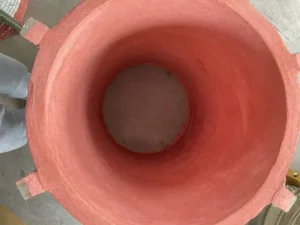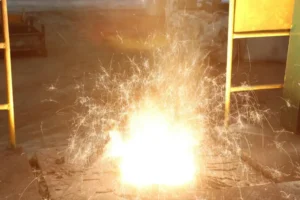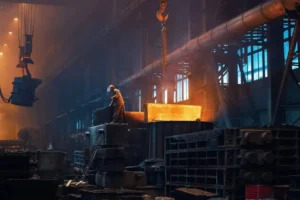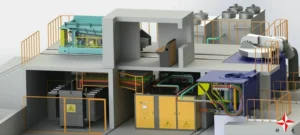With the increasing demands of industrial production for melting efficiency and capacity, high power induction furnaces are becoming increasingly popular. However, the increase in power also brings a series of technical challenges. Let’s analyze the potential technical bottlenecks and corresponding solutions.
Potential Technical Bottlenecks of High Power Induction Furnaces
- Grid Impact and Harmonic Pollution
- Challenge: During startup and operation, high-power induction furnaces draw a significant amount of active and reactive power from the grid, which can lead to voltage fluctuations and frequency changes, causing noticeable grid impact. Simultaneously, traditional medium-frequency power supplies using thyristors and other power electronic devices generate a large number of harmonic currents, polluting the grid, affecting the normal operation of other electrical equipment, and even endangering grid safety.
- Impact: Affects grid stability, potentially triggering grid protection mechanisms; reduces power quality, causing interference to other precision equipment; may require additional approval and restrictions from power authorities.
- Equipment Stability and Reliability
- Challenge: High-power operation means greater current and voltage stress, placing higher demands on the voltage and current withstand capabilities and heat dissipation performance of key components in the medium-frequency power supply (such as thyristors, IGBTs), transformers, capacitors, and induction coils. Long-term high-load operation can easily lead to equipment overheating, insulation aging, and component damage, affecting the stability and reliability of the equipment.
- Impact: Reduces production efficiency, increases maintenance costs, and may lead to unexpected downtime.
- Design and Cooling of Induction Coils
- Challenge: High power means the induction coil needs to withstand larger currents, generate stronger electromagnetic fields, and produce more Joule heat. Designing an induction coil with sufficient mechanical strength, good conductivity, and efficient cooling capacity is a key challenge. Traditional hollow copper tube cooling may not meet the heat dissipation requirements under high power.
- Impact: Overheating and deformation of the induction coil, insulation damage, and even short circuits, leading to equipment failure.
- Furnace Body Structure and Refractory Materials
- Challenge: High-power operation usually implies larger melting volumes and higher melting temperatures, which places higher demands on the strength and high-temperature resistance of the furnace body structure. At the same time, the electromagnetic stirring force during the melting process will also exert greater scouring and corrosion on the refractory lining.
- Impact: Deformation and damage of the furnace body structure, shortened lifespan of refractory materials, increasing maintenance costs and downtime.
- Electromagnetic Compatibility (EMC) Issues
- Challenge: High-power furnaces generate strong electromagnetic radiation during operation, which may interfere with surrounding electronic equipment, control systems, and even human health. Effectively suppressing and shielding electromagnetic radiation is an important technical issue.
- Impact: Affects the normal operation of surrounding equipment, potentially creating safety hazards.

Corresponding Solutions
- Solutions for Grid Impact and Harmonic Pollution
- Adopting Advanced Power Supply Topologies: For example, using rectifiers with twelve pulses or higher pulse numbers, or employing active power filters (APF) and static var compensators (SVC) can effectively suppress harmonic currents, improve power factor, and reduce impact on the grid.
- Soft Start Technology: Using soft start methods during equipment startup to gradually increase power, reducing the impact of startup current on the grid.
- Application of Energy Storage Devices: Introducing energy storage devices into the power system can provide or absorb large amounts of power in a short time, smoothing out grid fluctuations.
- Solutions for Equipment Stability and Reliability
- Selecting High-Quality Power Devices: Choosing power devices with higher voltage and current withstand capabilities and better heat dissipation performance, such as new high-power IGBT modules.
- Optimizing Heat Dissipation Design: Adopting more efficient cooling methods, such as forced air cooling, water cooling, or even immersion cooling, to ensure that key components operate within a safe temperature range.
- Strengthening Insulation Design: Using high-temperature and high-insulation strength materials to improve the insulation reliability of the equipment.
- Intelligent Monitoring and Protection Systems: Employing advanced sensors and control systems to monitor equipment operating status in real-time, implementing multiple protection functions such as overcurrent, overvoltage, and overheating, and promptly identifying and eliminating potential faults.
- Solutions for Design and Cooling of Induction Coils
- Optimizing Coil Structure: Adopting structural designs such as multi-turn parallel connection and segmented cooling to reduce current density and improve cooling efficiency.
- Using Efficient Cooling Methods: Using internally cooled hollow copper tubes to increase the contact area between the cooling water and the copper tube, improving heat dissipation; even adopting more advanced cooling technologies such as liquid metal cooling.
- Improving Mechanical Strength: Strengthening the support and fixation of the coil to prevent deformation under high electromagnetic forces and thermal stress.
- Solutions for Furnace Body Structure and Refractory Materials
- Optimizing Furnace Body Structure Design: Using stronger furnace body materials and structures to improve the overall strength and stability of the furnace.
- Selecting High-Performance Refractory Materials: Choosing new refractory materials with higher refractoriness, erosion resistance, and thermal shock resistance to extend the lifespan of the furnace lining.
- Adopting Advanced Refractory Lining Construction Techniques: Improving the integrity and scour resistance of the furnace lining.
- Optimized Control of Electromagnetic Stirring: By reasonably designing the structure and current frequency of the induction coil, optimizing the strength and direction of electromagnetic stirring to reduce localized scouring of the furnace lining.
- Solutions for Electromagnetic Compatibility (EMC) Issues
- Adopting Shielding Measures: Effectively shielding key components such as the medium-frequency power supply, induction coil, and furnace body to reduce the leakage of electromagnetic radiation.
- Optimizing Grounding Systems: Designing a reasonable grounding system to reduce common-mode interference.
- Using Filters: Installing electromagnetic compatibility filters at the power input and output ends to suppress the generation and propagation of electromagnetic interference.
- Complying with EMC Standards: The design and manufacturing of the equipment should comply with relevant electromagnetic compatibility standards.
Conclusion
Increasing the power of induction furnaces is a systematic engineering task involving multiple technologies. Solving the technical bottlenecks of grid impact, equipment stability, induction coil design and cooling, furnace body structure and refractory materials, and electromagnetic compatibility requires the comprehensive application of advanced power electronics technology, materials science, electromagnetic field theory, and control technology. Through continuous technological innovation and engineering practice, high power induction furnaces will be better able to meet the demands of modern industry for efficient, stable, and environmentally friendly melting.







